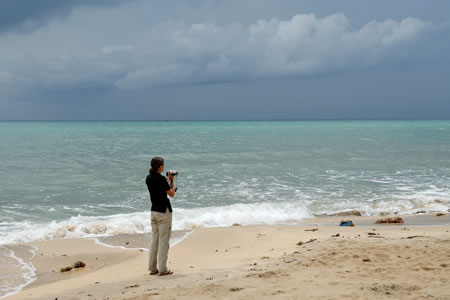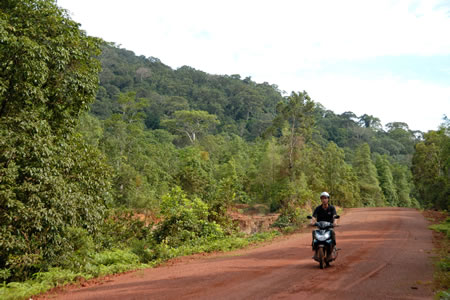English | Dutch |
|
| Phu Quoc, a tropical paradise | |
Long Beach (Vietnam), August 28th 2009 |
|
The Vietnamese island of Phu Quoc has everything that you can expect from a tropical island. It has white sandy beaches lined with swaying palms, an emerald blue sea and small fishing villages in where it looks that time stood still last decades. Phu Quoc is located in the very Southwest of Vietnam, a couple of hours by boat from the mainland. If you look at the map of the region, it looks like the island is part of Cambodia. But that is not true. In 1949, the island is allocated by the French colonisers to Vietnam, as part of their formal annexation of the Mekong delta. However, Cambodia still has a claim on this small but beautiful island. At this moment, Phu Quoc is still mainly undeveloped. The tourist industry is in the beginning of her development, there are no major building constructions yet and most of the roads on the island are unpaved. There are good gravel roads that connect even the remote parts of the island, and of course, there is an extensive maze of motorcycle paths. Despite the fact that still not many tourists know how to find the way to this tropical island, there is a wide range of accommodation available. From cheap low key resorts that rent simple bungalows on or near the beach, to top end resorts where all the luxury is available. Also the travelling to and from the island is quite simple these days. There are several fast boat connections every day between the island and the main land, and for the travellers that are on a tighter time schedule, there a 6 flights a day, by propeller plane, to/from Saigon (Ho Chi Min City). |
|
 |
|
Ivonne on Long Beach on Phu Quoc Island |
|
We travel by fast boat from the town of Rach Gia on the mainland to the island. The harbour where the boat arrives is exactly on the other side of the island than where most of the accommodation is. But that isn’t a problem, because many taxi drivers, minibus drivers and motorcycle taxis will hang around the harbour, looking for guests to bring them to a hotel. A tout approaches us immediately and offers us to bring us to Long Beach, the place where we want to stay, for € 2 per person. Long Beach is on the other side of the island, 20 kilometres from the harbour. And as expected, he also knows a good resort at Long Beach where the bungalows are between US$ 10.- (€ 7.15) and US$ 15.- (€ 10.70) per night. We agree with him that we will join him to take a look at the resort, but in case we do not like it, we are free to go to another place. When we arrive at the resort, it doesn’t take long to see that it is a great place. The bungalows are simple but clean. There is no air conditioning and hot water, but that is something you do not need on the island. The weather is warm enough to enjoy a refreshing shower once in a while and the sea breeze makes it not too hot, which means that sleeping at night is no problem. The bungalows are located in a shady garden, on an approximately ten second walk from the beach. After we dropped our backpacks in the US$ 12.- (= € 8.50) bungalow, we take a short rest in the hammocks on our private terrace, after which it is time for lunch. We take a table in the beach restaurant of the resort and have an absolute fabulous view on the emerald colour of the Gulf of Thailand. Here and there float some small fishing boats with men on it, who try to catch some fish with a small and simple fishing net. Also the food is very good. Two delicious curries, full with vegetables and fish, together with two plates of rice and a bottle of mineral water, costs us US$ 7.- (= € 5.-). And while we are enjoying the view, the weather changes. Dark clouds pack together above the island and the emerald blue colour of the sea changes in a dark and ominous colour. It doesn’t take long before a refreshing shower clashed from the sky. But an hour later, the rain is gone and the picturesque picture appears again. | |
 |
|
Exploring the interior of the island by motorbike |
|
| Our main reason to come to Phu Quoc is to relax, to do some reading, to enjoy the views and to work on our website. But while we are here, we also want to see some of the other parts of the island. That’s why we decided to hire a motorcycle for one day to explore the island. In the western countries, you need a special driving license for the 125 cc motorcycles, but not here in Vietnam. And because of the fact that the traffic is limited on the island and the speed low because of the bad roads, we decide to hire one. We drive to the northern part of the island, and because of the lack of direction signs, we are lost once in a while. But there is always a friendly local who offers some help when he or she notices that we aren’t sure what direction to take. The island isn’t that big, so getting lost isn’t a major problem. To the contrary, being lost brings you something to unexpected places like hidden beaches or ‘undiscovered’ fishing settlements.
Half way the day it is time to refuel our motorcycle. But as expected, there aren’t any gas stations in this more remote part of the island. However, there is always a solution in Vietnam. In every village there is a family that earns some extra money by providing fuel to passing motorcycles. You can recognise these places by small tables next to the road, with some litre bottles with gasoline on it. Often these bottles are the old glass Coca Cola bottles. When you need some gasoline, you just stop you motorcycle and ask to lady of the house to refill your iron horse. After that you pay a little inflated price, because of the fact that they make the gasoline available on the remote part of the island, after which you carry on with your trip. The red gravel paths takes us further along beautiful beaches, through small villages and green forests, and once in a while we have to navigate our motorcycle through a herd of cows that block to road. Our plan is to use the coastal path on the eastern side of the island to drive back to the central part again, but after nine kilometres we understand why the path isn’t on the maps anymore. We arrive at a small canyon, of which the small wooden bridge that once crossed the canyon, collapsed some years ago. There is no other option then to go back and to find another path that takes us back to Long Beach. | |